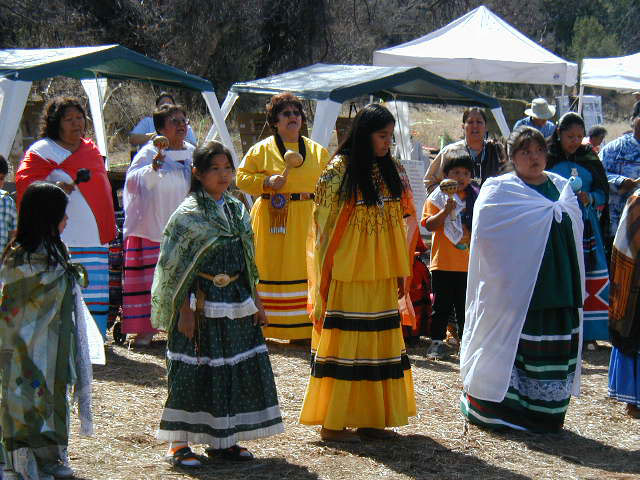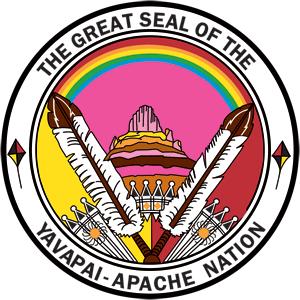The Yavapai-Apache Nation is centered on a reservation of more than 1,600 acres in the Verde Valley, 55 miles south of Flagstaff. The nation is actually a combination of two distinct tribes, the Yavapais and Tonto Apaches, each of which has their own dialect, history, and culture. Both tribes lived in the Verde Valley for centuries, with the Yavapais mostly to the west of the Verde River and the Tonto Apaches to the east. The two tribes often overlapped on this land, sharing resources and intermarrying.
For centuries Yavapai and Apache families and bands subsisted by hunting, gathering, and small-scale horticulture. They were deeply rooted to particular places based on their clan affiliations, even though they moved seasonally over a wide area to harvest wild plant and animals. They planted crops such as corn and melons in familiar places they would return to year after year, while ranging widely to hunt deer and collect agave, pinyon pine nuts, and other wild plant foods. The Yavapais and Apaches often traveled to the Grand Canyon in summer and fall when edible plants like pinyon nuts were abundant.
The Yavapais speak a dialect of the Yuman language. Historically, all Yuman tribes lived near the Colorado River, sharing a common creation myth that locates their origins at Spirit Mountain along the Colorado River near modern-day Bullhead City, Arizona. The Tonto Apaches, a subgroup of the Western Apache along with the White Mountain Apache and others, speak an Athabaskan language related to that of the Navajos. However, the Tonto Apaches became distinct from other Western Apache tribes with their adoption of farming and their intermarriage with the Yavapais.
When Euro Americans arrived in Arizona in the latter half of the 19th century, the Yavapai Apache semi-nomadic way of life became much harder to maintain. In 1871, President Ulysses S. Grant established a 900 square mile reservation for the Tonto Apaches. Two years later, Yavapais being confined elsewhere were transferred to this reserve. In fact, small bands of a number of different local Native American tribes with distant connections were sent to this reservation after being captured amidst the violence between Native Americans, the U.S. Army, and Euro American settlers. These included Southern Paiutes and Hualapais, whom the Yavapais and Apaches had likely encountered in their forays to the Grand Canyon and Colorado River.
Conditions were terrible on the reservation, with widespread starvation and disease. In 1875, the Yavapais, Apaches, and all others on their reservation, about 1,700 people, were forcibly removed, compelled to march through harsh winter weather and rough terrain to the San Carlos Apache Reservation. This resulted in the deaths of hundreds of tribal members and the loss of thousands of acres of treaty lands. While imprisoned, however, the Yavapais and Apaches formed even closer ties. When finally released in 1900, tribal members immediately began migrating back to their traditional homeland in small family groups, though only about 200 finally made it. In 1909 their reservation was re-established, although by this time Euro American settlers had moved into the area and taken over much of the originally-allotted land.
Under the Indian Reorganization Act of 1934, the federal government officially recognized the Yavapai Apache Tribe. In 1992 the tribe’s governing body created a revised tribal constitution that designated them as the Yavapai-Apache Nation. Today, around 2,000 Yavapai-Apache live on the Camp Verde Reservation, which consists of several parcels of land amounting to about 600 acres nestled within the Coconino National Forest. The reservation features many streams with rich flood plain soil deposits which supports tribal agriculture. Some of the goods produced include beef and dairy cattle, fruit, and irrigated crops such as hay and grains. There are also several tribal owned and operated enterprises including a construction company, convenience store, and RV park. However, most people are reliant on jobs funded by revenue from the tribal-owned Cliff Castle Casino.
For more information on the Yavapai Apaches, visit their tribal website at www.yavapai-apache.org
Written By Sarah Bohl Gerke
Suggested Reading:
- Basso, Keith H. Wisdom Sits in Places: Landscape and Language Among the Western Apache. Albuquerque: University of New Mexico Press, 1996.
- Griffin-Pierce, Trudy. Native Peoples of the Southwest. Albuquerque: University of New Mexico Press, 200
- Haley, James. Apaches: A History and Culture Portrait. Norman: University of Oklahoma Press, 1997.
- Worcester, Donald E. The Apaches: Eagles of the Southwest. Norman: University of Oklahoma Press, 1979



